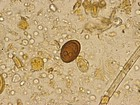Dicrocoelium dendriticum
| Also known as: | Dicrocoelium lanceolatum
|
Scientific Classification
| Kingdom | Animalia |
| Phylum | Platyhelminthes |
| Class | Trematoda |
| Order | Diagiorchiida |
| Family | Dicrocoeliidae |
| Genus | Dicrocoelium |
| Species | D. dendriticum |
- This is a small fluke (<1.5cm) found in the bile ducts of ruminants and some other herbivores
- The flukes migrate directly up the common bile duct to reach the bile ducts within the liver
- They are therefore much less pathogenic than Fasciola (which burrow through the liver parenchyma)
- Dicrocoelium is rare in Britain, occurring mainly in the Hebrides, but is common in Europe
- Small dark-brown eggs are shed in faeces
- These contain a miracidium
- If ingested by a land snail, the flukes develop, forming cercariae
- These are excreted by the snails in slime-balls, which are collected and eaten by wood-ants
- Metacercariae form inside the ants
- The final host is infected when ants are eaten at grazing
- The presence of metacercariae in the nerve ganglia of the ants makes them revert to a primitive behaviour pattern, whereby they cling onto herbage overnight instead of retreating to the nest enhancing the likelihood of being eaten by grazing animals

